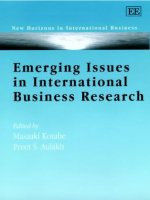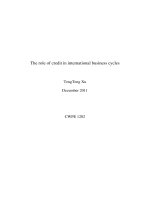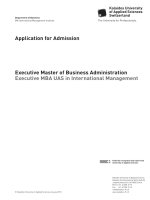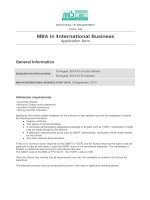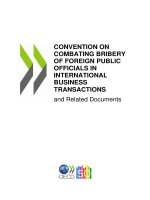Careers in international business 2003
Bạn đang xem bản rút gọn của tài liệu. Xem và tải ngay bản đầy đủ của tài liệu tại đây (558.72 KB, 161 trang )
VGM Professional Careers Series
INTERNATIONAL
BUSINESS
EDWARD
J.
HALLORAN
SECOND EDITION
Copyright © 2003 by The McGraw-Hill Companies, Inc. All rights reserved. Manufactured in the United States of America. Except
as permitted under the United States Copyright Act of 1976, no part of this publication may be reproduced or distributed in any
form or by any means, or stored in a database or retrieval system, without the prior written permission of the publisher.
0-07-142507-1
The material in this eBook also appears in the print version of this title: 0-07-140735-9
All trademarks are trademarks of their respective owners. Rather than put a trademark symbol after every occurrence of a trademarked name, we use names in an editorial fashion only, and to the benefit of the trademark owner, with no intention of
infringement of the trademark. Where such designations appear in this book, they have been printed with initial caps.
McGraw-Hill eBooks are available at special quantity discounts to use as premiums and sales promotions, or for use in corporate training programs. For more information, please contact George Hoare, Special Sales, at
or (212) 904-4069.
TERMS OF USE
This is a copyrighted work and The McGraw-Hill Companies, Inc. (“McGraw-Hill”) and its licensors reserve all rights in and
to the work. Use of this work is subject to these terms. Except as permitted under the Copyright Act of 1976 and the right to
store and retrieve one copy of the work, you may not decompile, disassemble, reverse engineer, reproduce, modify, create derivative works based upon, transmit, distribute, disseminate, sell, publish or sublicense the work or any part of it without McGrawHill’s prior consent. You may use the work for your own noncommercial and personal use; any other use of the work is strictly
prohibited. Your right to use the work may be terminated if you fail to comply with these terms.
THE WORK IS PROVIDED “AS IS”. McGRAW-HILL AND ITS LICENSORS MAKE NO GUARANTEES OR WARRANTIES AS TO THE ACCURACY, ADEQUACY OR COMPLETENESS OF OR RESULTS TO BE OBTAINED FROM
USING THE WORK, INCLUDING ANY INFORMATION THAT CAN BE ACCESSED THROUGH THE WORK VIA
HYPERLINK OR OTHERWISE, AND EXPRESSLY DISCLAIM ANY WARRANTY, EXPRESS OR IMPLIED, INCLUDING BUT NOT LIMITED TO IMPLIED WARRANTIES OF MERCHANTABILITY OR FITNESS FOR A PARTICULAR
PURPOSE. McGraw-Hill and its licensors do not warrant or guarantee that the functions contained in the work will meet your
requirements or that its operation will be uninterrupted or error free. Neither McGraw-Hill nor its licensors shall be liable to you
or anyone else for any inaccuracy, error or omission, regardless of cause, in the work or for any damages resulting therefrom.
McGraw-Hill has no responsibility for the content of any information accessed through the work. Under no circumstances shall
McGraw-Hill and/or its licensors be liable for any indirect, incidental, special, punitive, consequential or similar damages that
result from the use of or inability to use the work, even if any of them has been advised of the possibility of such damages. This
limitation of liability shall apply to any claim or cause whatsoever whether such claim or cause arises in contract, tort or otherwise.
DOI: 10.1036/0071425071
Want to learn more?
,
We hope you enjoy this McGraw-Hill eBook! If you d like
more information about this book, its author, or related books
and websites, please click here.
In memory of Cathy and Jay Tarrant and Dick Murdy
This page intentionally left blank.
For more information about this title, click here.
CONTENTS
Foreword
ix
Acknowledgments
Introduction
xiii
xv
CHAPTER 1
Today’s Global Business World
1
Free Trade • Protectionism • Where the Jobs Are • Risks •
Economic Expansion: What the Experts Say • A Commitment
to Learning • Assessing Your Knowledge
CHAPTER 2
Language, Culture, and Communications
11
Conducting Business in Different Cultures • Don’t Limit
Yourself • Preparing to Work Overseas: What the Experts Say
CHAPTER 3
Career Goals and Attainment
23
What Do You Want to Do? • Education • Identify and
Strengthen Your Skills • View Your Options Realistically •
The Cover Letter • Your Resume • The Interview Process
v
Copyright 2003 by The McGraw-Hill Companies, Inc. Click Here for Terms of Use.
vi
CHAPTER 4
Contents
Has International Business Education Changed?
39
Market Demand • Curriculum • Study Abroad/International
Travel • Globalization • Conclusion
CHAPTER 5
Three Modes of Employment
45
Permanent Employment • Contract Work • Starting Your
Own Business
CHAPTER 6
Careers in International Sales and Marketing
55
Sales Careers • Marketing Careers
CHAPTER 7
Teaching English Abroad
71
“Want to Work Overseas? Teach English!” • Additional
Considerations • Meet an Expert • One Last Note
CHAPTER 8
An Introduction to Basic Resume and Cover
Letter Writing
81
The Elements of an Effective Resume • Writing Your Resume •
Assembly and Layout • The Cover Letter
APPENDIX A
Intercultural Assessment, Training, and
Development
107
APPENDIX B
American and Canadian Undergraduate
Programs in International Business
111
vii
APPENDIX C
Contents
American and Canadian Graduate Programs in
International Business
121
APPENDIX D
Additional Resources
Recommended Readings
131
137
This page intentionally left blank.
FOREWORD
This foreword is written to congratulate all of you who have chosen international business as a vocation. You are entering an exciting field of enormous opportunity and challenge, particularly within the realm of free
trade.
Free trade is something that I believe will, inevitably, change the way we
do business throughout the world.
Consider the recent dramatic admittance of China to the World Trade
Organization and Russia’s rapidly expanding trade with the rest of the
world. Both of these developments will open many previously nonexistent
trade avenues to international companies.
While there are many free trade agreements being negotiated in the
world today, I want to limit my comments to one of the most important
free trade agreements ever proposed for those who live in the Western
Hemisphere: the Free Trade Agreement of the Americas (FTAA).
An FTAA composed of all countries in the Western Hemisphere is a
prospect that holds tremendous potential. It could create the strongest trading block in existence. Only Cuba, as a communist dictatorship, would be
excluded.
The FTAA was the brainchild of President George H. W. Bush, in
response to changed circumstances at the end of the Cold War. His administration negotiated the North American Free Trade Agreement (NAFTA),
consisting of Canada, the United States, and Mexico. He promoted the Asia
Pacific Cooperation Pact (APEC) and supported a free trade agreement
ix
Copyright 2003 by The McGraw-Hill Companies, Inc. Click Here for Terms of Use.
x
Foreword
with Chile. His push of the Uruguay global trade talks resulted in competitive efforts from the European Union (EU) to complete the global
Uruguay Round trade negotiations. These historic events marked the
beginning of unprecedented growth in free trade agreements.
But it is true that a rising tide raises all ships. No one can dispute the
success of NAFTA when you look at the numbers. Trade among Canada,
Mexico, and the United States, which in the 1990s was $230 billion, grew
to $655 billion in 2000. In contrast, trade between the United States and
the EU, which in 1990 was $190 billion, grew to only $384 billion in 2000.
The trade gap between NAFTA and the EU is widening. In 2000, the United
States had 71 percent more trade with its NAFTA partners than with the
EU.
Under NAFTA, Mexico has increased exports from $61.4 billion in 1993
to $182 billion in 2000. Foreign direct investment in Mexico increased from
$4.4 billion in 1993 to $13.5 billion in 2000. Contrary to concerns voiced
by NAFTA’s opponents in the United States, NAFTA has created jobs in all
three countries. In the United States alone, it’s estimated that 350,000 jobs
were created due to NAFTA-related exports during the first five years of the
pact.
Countries that engage in free trade and democratic reforms are much
more prosperous. In Mexico, a middle class is slowly emerging, along with
a more open and democratic society. The first opposition-party president
in Mexico was elected in 2000, when Vicente Fox of the PAN party was
elected president in a free election. Then-president Ernesto Zedillo, a member of the then-ruling party, the PRI, incurred the wrath of his party by
guiding free and open elections, which cost his party’s candidate the
presidency.
Our current president, George W. Bush, has promised to bring the FTAA
to fruition by 2005. He has a formidable task ahead of him. In 1994, when
President Clinton began negotiations for an FTAA by hosting a Miami summit, North and South American leaders agreed to have the FTAA in place
by 2005. However, fearful of alienating protectionist political constituencies, President Clinton was unwilling to build on NAFTA or even defend it.
In 1997, the Democratic party in Congress refused to support him in his
request for authority to negotiate any free trade agreements.
Lasting consequences remain as a result of this lack of support. Recognizing the strategic value of NAFTA, countries throughout Latin America
were competing to negotiate free trade agreements with the United States
in the 1990s. At that time, they wanted to connect their economies, societies, security, and even their political systems to the United States. But we
failed to seize those opportunities, so Latin America has proceeded with
its own customs union, negotiating new trade ventures with the EU and
Japan.
Although Latin America remains dubious, the United States is moving
forward. President Bush remains committed to the FTAA and has made it
a priority of his administration.
An FTAA would unite the Western Hemisphere in ways we can barely
imagine: visualize a tariff-free zone linking over 800 million people, producing over $11 trillion in goods and services, and creating the world’s
largest common market—far bigger than the European Union.
Imagine a hemisphere where all democratic countries have full access to
each others’ goods and services. Where closed economies are opened and
citizens have the opportunity to work and achieve economic prosperity.
Where mothers and fathers can support their families without crossing borders to find jobs. Where disputes between countries are settled by the rule
of law and not by armies and border wars. Free trade just may hold this
promise.
But that is fodder for a future book. In the meantime, it’s up to the next
generation (you!) to lead the world into the most open and free trade we
have ever seen. Opportunities abound for those who are willing to make
the commitment. I wish you good fortune and I trust your efforts will lead
us down the path to global peace and prosperity.
George Heinrich
President, Heinrich Advertising and Direct Marketing
Chairman of the Board of Directors, Chamber of the Americas
xi
Foreword
This page intentionally left blank.
ACKNOWLEDGMENTS
This book, now in its second edition, has taken on a life of its own through
the years, and I’m grateful to a rather large number of people who have
taken the time to make suggestions concerning its content.
The late John Tarrant was the first to recognize the need for this book,
and Sarah Kennedy and Betsy Lancefield Lane worked long and hard to help
me bring it into existence.
Robert Wing, the former president of IHS International, has been a constant source of useful information and suggestions, and the editors at VGM
Career Books—particularly Denise Betts, Ellen Vinz, and Monica Stoll—
have had a great deal to do with shaping the second edition.
Students, clients, and academic and corporate colleagues too numerous
to mention here (although some of their names appear in the text) have
also taught me a great deal, and I’ve attempted to include their ideas and
address their concerns as I worked on this updated edition.
Finally, as ever, I’m indebted to my wife, Maria Cristina, for her love and
support.
xiii
Copyright 2003 by The McGraw-Hill Companies, Inc. Click Here for Terms of Use.
This page intentionally left blank.
INTRODUCTION
F
or simplicity’s sake, citizens of the United States are described throughout this book as “Americans,” but keep in mind that people from Central
and South America view themselves as Americans, too.
More accurately, we are “North Americans” and are referred to this way
by our fellow Americans to the south. (In Spanish, the feminine term is
norteamericana, and the masculine version is norteamericano.) A useful way
to remind ourselves of this is to remember that the United States is a member of the Organization of American States (OAS). While people from
Europe, Asia, Africa, Australia, and even Canada (another OAS member)
are likely to refer to U.S. citizens as “Americans,” people from other countries in our region may find us offensive if we arrogate this term for
ourselves.
BE PREPARED
There are jobs in the international sector for U.S. and Canadian citizens,
and all indications are that there will be many more as time goes by. Unfortunately, many Americans are often ill-prepared to compete for these positions. The fact is, many foreign nationals are better educated (except,
perhaps, in the technical areas) than their American counterparts. First of
all, foreigners tend to know their own language thoroughly, while functional illiteracy is fairly common in the United States. As a rule, Americans
xv
Copyright 2003 by The McGraw-Hill Companies, Inc. Click Here for Terms of Use.
xvi
Introduction
often do not write well, and this greatly reduces their employability in the
international sector.
In addition to great facility in their own tongue, many foreigners in the
business world also speak one or more foreign languages fluently. Meanwhile, the average American who has “studied” another language is hard
pressed to get beyond observing, “My aunt’s pen has fallen off the dresser.”
English is the foreign language of choice for many people in the international business community, and they tend to speak it well. They are also
fully conversant with geography and often know more about the world
(including the United States) than do their American counterparts.
Americans can land international jobs, but to do so they must study
harder on an ongoing basis. The world is in a constant state of political,
economic, and social change, and people who want to succeed in what has
become a global market for goods, ideas, and services will need to keep
abreast of these changes.
This book is designed to help Americans prepare to compete for international positions. Many, but not all of these jobs, will be in sales and marketing. We will look at where the opportunities lie for a variety of positions,
including traditional jobs, contract work, and increasingly, excellent opportunities for entrepreneurs.
Surprisingly, most of the opportunities for international work will be
right here in the United States, and, in many cases, Americans will be working for foreign companies.
A well-prepared American has a great deal to offer a foreign firm, and
challenging opportunities abound for people who are willing to continue
to learn and grow. This book will provide a method for finding and keeping positions in the exciting world of international business.
HOW TO USE THIS BOOK
The mere fact that you are reading this book indicates that you have given
at least a little thought to looking into career opportunities in the international sector. This text will help you determine if you are truly cut out for
a career in international business, and in the process you will be exposed
to other possibilities you may not have thought of.
Salary ranges have been left out on purpose, because if a given career
does not appeal to you on its own merits, you are not going to be happy for
very long, no matter how much money you’re making. When you are asked
to answer questions, be honest with yourself. No one can help you unless
you have determined what it is that you want to go after and what your
strengths and shortcomings are.
The sources mentioned throughout the book will provide you with a
great deal of useful information. However, understand that you are reading a primer and that you will need to do more research on your own.
Be open-minded as you read the book and in your subsequent pursuit
of knowledge. Too often in the past, Americans have tended to take a narrow look at the rest of the world. It was tasteless then, and it is economic
suicide now because we need other countries’ business more than they need
ours. In short, it behooves us to become better citizens of the world and
open ourselves to new possibilities. And why not? It is not only good business, it is enjoyable!
xvii
Introduction
This page intentionally left blank.
C H A P T E R
1
TODAY’S
GLOBAL
BUSINESS
WORLD
Upon completion of this chapter, you should be able to:
• Appreciate the nature of change in the global economy
• Weigh the pros and cons of working in the international sector,
given the expansion of terrorist activities
• Understand the nature of your competition for international
positions
• Commit to a lifelong contract with yourself to continue to learn
and grow
FREE TRADE
While the expansion of NAFTA has, indeed, hurt some companies in the
United States and Canada, it has also expanded many markets for U.S. and
Canadian products, commodities, and, yes, workers. NAFTA, like the global
economy itself, is all about change, and the inflexible will find themselves
left behind. Happily, that doesn’t need to be the case for you if you’re willing to commit to a lifelong pursuit of knowledge (including learning new
skill sets) and cultural growth, and that’s what this book is designed to help
you to do.
For several years I cochaired the marketing subcommittee of the Rocky
Mountain chapter of the U.S.-Mexico Chamber of Commerce. I watched
1
Copyright 2003 by The McGraw-Hill Companies, Inc. Click Here for Terms of Use.
2
CAREERS IN
INTERNATIONAL
BUSINESS
our leader, Gil Cisneros, build a vibrant group, and in the process, learn
that in order to truly serve our region in the area of economic expansion,
he’d need to expand his horizons. Together with George Heinrich, he
founded the Chamber of the Americas, which is growing at a rapid rate.
During the 1997 Denver “Summit of the Eight” (the leaders of the G-7
nations and Russia), it became clear that many of the old barriers to trade
were falling. A year later, NewTech ’98, a Vatican-sponsored computer conference, brought together clergy and corporate executives from all over the
globe with the goal of improving communications within the Roman Catholic Church, and with the secular world, knocking down additional
barriers.
In today’s wide-open global marketplace, even devalued currencies are
no obstacle. For example, as a Russian businessman recently said to me,
“The fluctuations of the ruble aren’t a barrier to trade. We can provide certificates for timber, gold, and petroleum, all of which we have in abundance, and they’re fully fungible.”
China, according to Angel Chi, the president of the China Development
Institute, is also firmly committed to Western-style marketing. “In 1999,”
Chi says, “China began their ‘Western Development Campaign,’ hoping to
attract a combination of investors and experts in many fields. The program
is ongoing, and is designed to boost the economy of China’s western
region—specifically the provinces of Shaanxi, Sichuan, Chongqing,
Guizhou, Guangxi, Yunnan, Ningxia, Inner Mongolia, Gansu, Quinghai,
Tibet, and Xinjiang. The need for expertise is ongoing, as China is going to
host the Olympics in 2008, and realizes what a global showcase that will
be. As a result, opportunities will expand during the years leading up to the
Olympics.”
This is a particularly exciting time to look for work in the international
sector, as truly unprecedented opportunities are available.
PROTECTIONISM
The term global village has been with us for some time now. The world’s
governments have begun to acknowledge that we are in a single, marketdriven global economy. NAFTA and GATT are two relatively recent admis-
sions that we are all inextricably intertwined with one another in a single
marketplace, and that trade restrictions are ultimately self-defeating. So,
ever so slowly, we are moving in the direction of truly free trade.
Protectionism withers in the face of economic reality. If what a company is doing is not cost-effective, even its domestic customers will ultimately shop elsewhere. The proliferation of Japanese cars in the U.S. market
is a good case in point. For many years, the Japanese made cars for less
money than their American counterparts—even during periods when
Japanese autoworkers were being paid more than U.S. autoworkers—
because Japanese factories were, to the greatest extent possible, using industrial robots.
In addition to effecting various economies in the workplace, the Japanese were more responsive to the needs of the American market, making
changes in vehicle size and style as the market dictated. Meanwhile, American autoworkers criticized the Japanese and asked, “Why don’t they buy
our cars?” The “they” actually included not only the Japanese, but also people in the United States. On the domestic front, people were buying foreign
cars because they were sick of Detroit’s gas guzzlers. Meanwhile, people in
Japan were not buying even the most prestigious U.S. cars—because in
Japan, as in England, the steering wheel is on the right side of the car. U.S.
automakers were trying to sell them typical American cars with the steering wheels on the left! We as a nation paid for this error, among others, with
an unfavorable balance of trade.
Although the automotive industry’s criticism of Japan was largely irrational, the Japanese have maintained restrictive barriers against foreign—
chiefly U.S.—goods (including agricultural products) that are usually less
expensive and often better than their Japanese rivals’ offerings. This protectionism has hurt Japan, and slowly, accommodations are being made.
But the process is painful because in Japan, as in other countries, powerful domestic groups such as unions and industry associations aggressively
attempt to maintain trade barriers.
The barriers are, however, gradually disappearing, and major concessions have been made in recent years. You have only to look at the Japanese
and other foreign-owned factories in the United States to understand that
we are in a time of significant change, and that we need to prepare ourselves to deal with it.
3
Today’s Global
Business World
4
CAREERS IN
INTERNATIONAL
BUSINESS
Ray Morgan, an international marketer, made the following comments
about protectionism: “Protecting the American automobile industry by
permitting the engines to be made in the East, the bodywork in Mexico,
and then installing Canadian-made seats in Detroit so the car qualifies as
an ‘American-made product’ puts the cause of international marketing and
‘free trade’ back into the seventeenth century. . . . Manufacturers must produce a superior product with quality that will withstand competition from
around the world. . . . We must think global markets, but first remove the
invisible barriers.”
WHERE THE JOBS ARE
Just as American Express was pulled into the world of international banking many years ago when immigrants sent money orders that were meant
to be used in the United States back to their families in Europe, more and
more American firms have discovered that new markets are opening up to
them overseas, which leads to more and more opportunities for Americans
to work in the international sector.
However, the jobs are increasingly likely to be in the United States itself.
This is because, in addition to adhering to foreign governments’ dictates
that the bulk of the employees of U.S. firms doing business there be locals,
there are other valid reasons for not sending inexperienced Americans
abroad. As a senior executive in a large firm’s international department told
me, “By letting local nationals serve as our primary contacts abroad, I eliminate the risk of having an American approach a prospective customer in
the wrong way. I let the locals set things up, and I don’t have to worry about
them telling the wrong kind of joke or being too pushy. Overseas, as a general rule, people want to get to know representatives of commercial firms
as people first, before business is ever discussed. Most Americans have a
difficult time dealing with this and, in many cases, the cultural and linguistic knowledge required to open doors abroad requires many years of
study—indeed, you might even say a lifetime.”
I asked him, “Once opened, is there a place inside the door for an
American?” He replied, “Yes, if he or she is an expert at something, such
as technical knowledge or finance. Using the local nationals on an ongo-
ing basis to smooth the way for them, Americans can make significant
contributions.”
RISKS
A great deal has happened since the first edition of this book was published
in 1996, and I’d be remiss if I didn’t address the more negative aspects of
what’s transpired, specifically both domestic and international terrorism.
There has been an exponential increase in terrorist acts, not only overseas, but also in the United States. Assassinations, both political and gangrelated, have long been part of the American scene, and the Oklahoma City
bombing made it very clear that domestic terrorists are every bit as deadly
as their foreign counterparts. Many places I’ve loved being in have been the
venue for truly horrific acts—Tel Aviv, Haifa, Jerusalem, Paris, London,
Cairo, Mexico City, Tijuana, Madrid, and Manila are just a few.
That said, if we’re afraid to do things because of violent people, nothing worthwhile will ever be accomplished. Many people feel that living and
working abroad are well worth the risks and that their lives are richer for
those experiences.
Yes, terrorists will continue to ply their trade, both in North America
and abroad, but, putting it mildly, if working in international business is
your goal, don’t be deterred—the rewards far outweigh the risks.
ECONOMIC EXPANSION: WHAT THE EXPERTS SAY
Ray Morgan is a major international marketer in the specialty advertising
industry. Here are some of the things he has to say about the global marketplace and the people who want to work in it:
What’s the nature of the United States’ position in the global marketplace?
Economic survival for the United States now means seeking new markets.
We must sell what we do best—education, technology, and whatever manufacturing remains—to reach the purchasing power of the world. We can
5
Today’s Global
Business World

